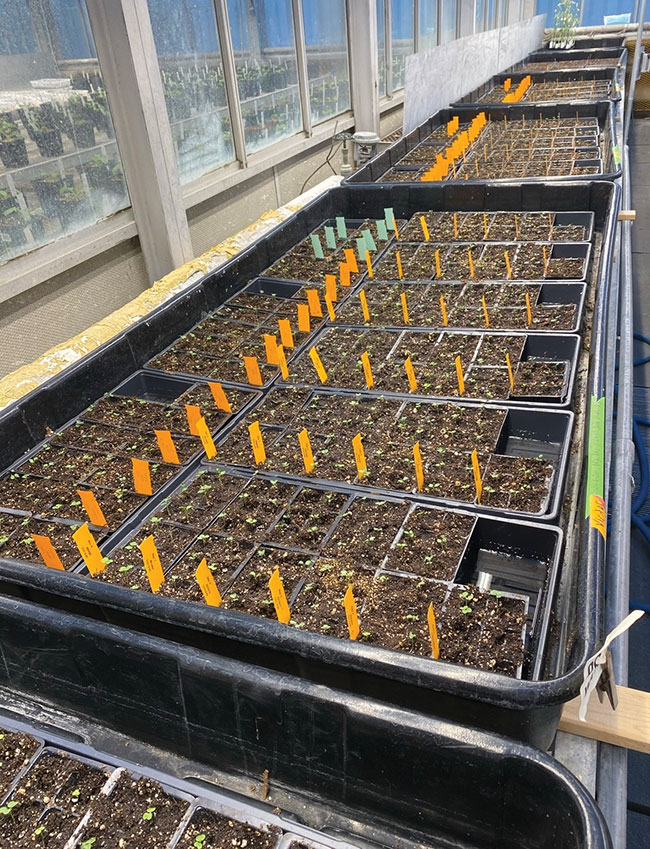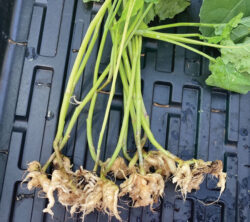
Features
Canola
New clubroot pathotypes and second-generation resistance
Clubroot resistance stewardship remains a priority for mitigating disease risk.
May 3, 2023 By Donna Fleury
 Canola seedlings prepared for clubroot virulence testing under greenhouse conditions.
Photo courtesy of Keisha Hollman, PhD Student, University of Alberta.
Canola seedlings prepared for clubroot virulence testing under greenhouse conditions.
Photo courtesy of Keisha Hollman, PhD Student, University of Alberta. Canola growers rely on genetic resistance as one of the most efficient and effective tools for managing clubroot disease, along with other best management practices. In recent years, as resistance has come under pressure from the emergence of ‘new’ pathotypes of the clubroot pathogen, there has been a concerted effort to develop canola with novel resistance traits. However, the pathogen Plasmodiophora brassicae continues to evolve putting the resistance of even new cultivars at risk.
“Since 2009, many cultivars with clubroot resistance have been released,” says Stephen Strelkov, professor of plant pathology at the University of Alberta. “Most of the original clubroot-resistant cultivars carried what is now generally referred to as ‘first-generation’ resistance. This resistance came largely from a winter oilseed rape variety Mendel and was highly effective against many clubroot pathotypes.
“Unfortunately, in many fields, new pathotypes have been able to overcome first-generation sources of genetic resistance in commercial canola varieties, leading breeders to develop multiple new cultivars carrying what is often called ‘second-generation’ resistance. These second-generation varieties are considered to have some differences in the basis of their clubroot resistance compared with the first-generation varieties. However, the nature of the differences is not in the public domain and may differ across varieties, so that not all second-generation resistance is the same.”
This new resistance may also be at risk, as some fields with second-generation clubroot resistant canola have developed symptoms of clubroot disease in recent years. Strelkov initiated a three-year project starting in 2021 to gain a better understanding of the virulence of P. brassicae on second-generation resistance and to determine the pathotype composition on second-generation clubroot-resistant canola recovered from commercial fields.
Researchers also want to evaluate the infectivity and cross-infectivity of the most important P. brassicae pathotypes on a suite of canola cultivars with second-generation resistance.
“The overall objective of the project is to monitor and assess pathogen populations collected from commercial fields that may be able to overcome the resistance of some of these second-generation varieties and to compare them with first-generation resistance,” explains Strelkov. “In our yearly monitoring, we found some fields in Alberta that had second-generation resistant varieties that were starting to show symptoms of clubroot. We collected infected root samples from commercial fields and extracted pathogen isolates. We then inoculated first-generation and second-generation hosts with those pathogen isolates under controlled conditions in the greenhouse and compared the results to a susceptible host with no resistance. We are trying to understand the virulence of P. brassicae and any new pathotypes that may be emerging, and compare the reactions of the different hosts.”

A canola field in Alberta’s prairie farmland, where, since 2003, clubroot has been confirmed in 46 counties or municipalities or 70 per cent of all districts where canola is grown.
Photo courtesy of LaurieSH /ADOBE STOCK.
For the trials, seven second-generation canola cultivars have been tested to date against 23 pathogens isolates, as well as control isolates representing key pathotypes. While further testing is underway, the results so far have indicated differences in the responses of the cultivars to the pathogen isolates.
For the second-generation cultivar trials, two cultivars performed well against all of the isolates, with a disease severity of less than 20 per cent, two cultivars had a disease severity of 30 to 40 per cent and three cultivars showed disease severity of 60 to 80 per cent.
There were also two second-generation varieties that were susceptible to 3-H, an older clubroot pathotype that was dominant when first-generation cultivars were introduced. Overall, the results show some of the second-generation varieties are holding up pretty well.
“For now, the best strategy for growers is to switch up cultivars if they find that some varieties are not performing very well,” says Strelkov. “If growers have been relying on first-generation cultivars and are seeing evidence of clubroot disease, then definitely try some of the products advertised as having something different or second-generation. There is no guarantee they will work in all fields, but it is better than growing the same variety over again, and there is a good chance the new varieties will have a different resistance package and might perform quite well. As part of clubroot management, longer rotations are also recommended. Some of our previous research, along with work completed by Gary Peng and other researchers, shows that leaving two years between canola crops is much better than one year, decreasing field spore-loads by as much as 90 per cent.
“A much greater proportion of the spore-load declines in the second year versus the first year. It is really a numbers game, with the greater the number of spores left in the soil, the greater the risk of the pathotypes that break the resistance.”
Strelkov is also continuing disease surveys for clubroot and pathotyping of the pathogen in a complementary project. In 2022, a survey led by the University of Alberta in collaboration with Alberta Agriculture and Irrigation, counties and municipalities, identified an additional 300 clubroot field infestations in Alberta.
Clubroot is now confirmed in 46 counties or municipalities, or in 70 per cent of all districts where canola is grown in Alberta since 2003. Clubroot definitely continues to spread in Alberta, and there are at least 3,894 individual fields known to have the presence of the pathogen.
To date, Saskatchewan has not reported any pathotypes overcoming resistance in either first- or second-generation cultivars, while Manitoba has a couple of isolated issues with first-generation cultivars, but no cases of second-generation resistance breaking identified so far.

Canola roots heavily infected by clubroot pathotype 3H under greenhouse conditions.
Photo courtesy of Keisha Hollman, PhD Student, University of Alberta.
“To date, the two most predominant pathotypes in Alberta are 3A and 3D, both of which are widespread and common, and both of which overcome first generation resistance,” adds Strelkov. “The third most predominant pathotype is 3H, which was the most common pathotype before clubroot-resistant cultivars were introduced to Western Canada. It is controlled by most resistance sources. Some other pathotypes are also increasing in prevalence in recent years, but tend to be more isolated geographically. For example, pathotype 8E has been increasing in more localized areas south of Edmonton, such as Leduc County, while 9E has been identified in the Red Deer region. We don’t know if these pathotypes will keep increasing, but it is important to keep an eye on emerging and existing pathotypes so we continue to develop appropriate mitigation measures.
“Clubroot resistance stewardship remains the priority for mitigating disease risk and the impact of the disease,” emphasizes Strelkov. “Resistance is such an important management tool and we don’t want to lose it. For growers with clubroot issues, stretch out rotations as much as possible and add more diversity even if that is just switching varieties from first-generation to second-generation. If one type of resistance breaks down, others may still be effective if they have a different genetic basis.
“Although researchers and breeders have characterized multiple sources of resistance, introgression of resistance in new varieties is not that easy. Therefore, implementing a multi-pronged approach to clubroot management remains a priority for growers and the canola industry.”